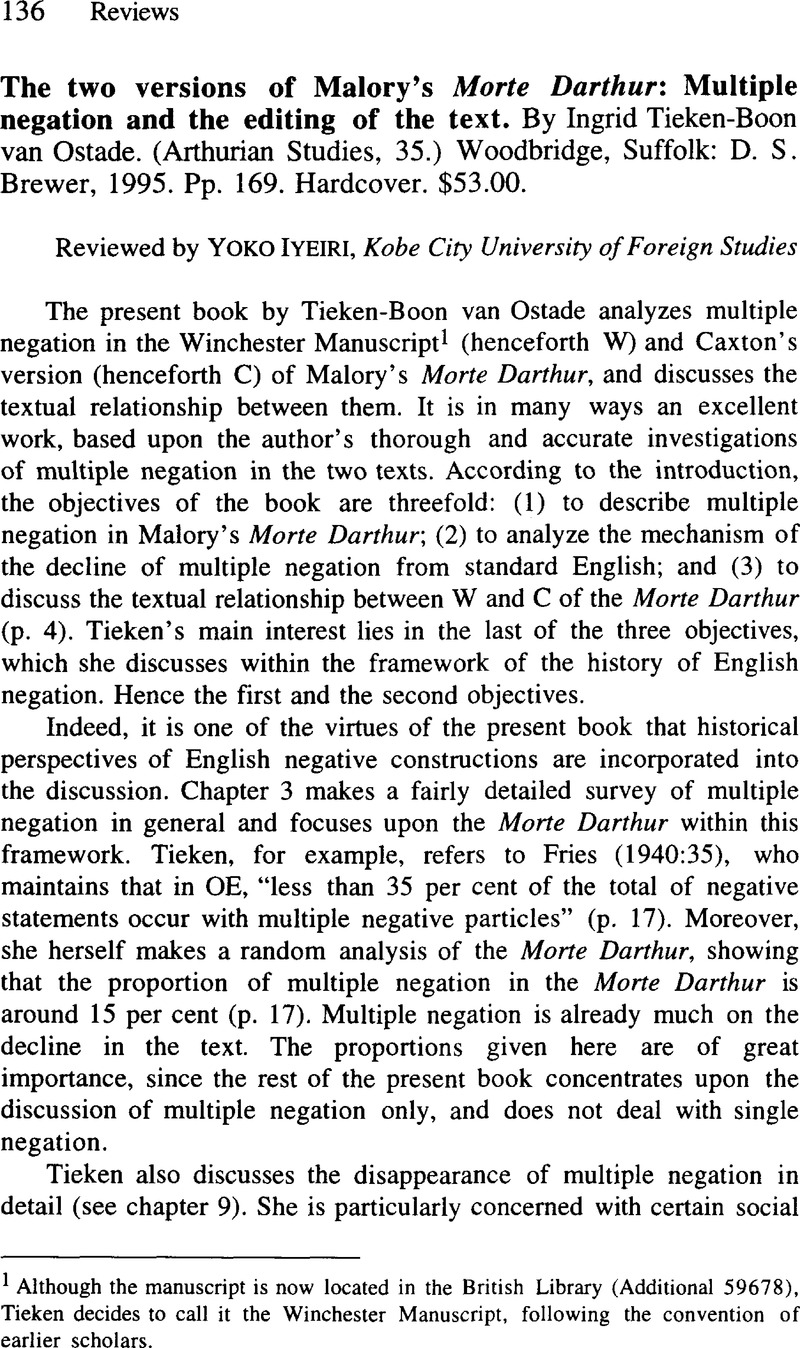No CrossRef data available.
Article contents
The two versions of Malory's Morte Darthur: Multiple negation and the editing of the text. By Ingrid Tieken-Boon van Ostade. (Arthurian Studies, 35.) Woodbridge, Suffolk: D. S. Brewer, 1995. Pp. 169. Hardcover. $53.00.
Published online by Cambridge University Press: 05 December 2008
Abstract
An abstract is not available for this content so a preview has been provided. Please use the Get access link above for information on how to access this content.

- Type
- Reviews
- Information
- Copyright
- Copyright © Society for Germanic Linguistics 1997
References
REFERENCES
Dekeyser, Xavier. 1990. The prepositions with, mid and again(st) in Old and Middle English: A case-study of historical lexical semantics. Belgian Journal of Linguistics 5.35–48.CrossRefGoogle Scholar
Dekeyser, Xavier. 1994. The mutual quantifiers much/many and their analogues: A historical lexico-semantic analysis. Leuvense Bijdragen 83.289–99.Google Scholar
Fischer, Olga. 1992. Syntax. The Cambridge history of the English language. Volume II: 1066–1476, ed. by Blake, Norman, 207–408. Cambridge: Cambridge University Press.CrossRefGoogle Scholar
Fries, Charles C. 1940. American English grammar. New York and London: S. Appleton-Century Company.Google Scholar
Hellinga, Lotte. 1977. The Malory manuscript and Caxton. In Hellinga and Kelliher, 91–101.Google Scholar
Hellinga, Lotte. 1981. The Malory manuscript and Caxton. Aspects of Malory, ed. by Takamiya, Toshiyuki and Derek, Brewer, 127–41. Cambridge: D. S. Brewer.Google Scholar
Hellinga, Lotte. and Kelliher, Hilton. 1977. The Malory manuscript. British Library Journal 3.91–113.Google Scholar
Iyeiri, Yoko. 1992. Negative constructions in selected Middle English verse texts. Doctoral dissertation, University of St. Andrews, Scotland.Google Scholar
Iyeiri, Yoko. 1995. Negative contraction and syntactic conditions in Middle English verse. English Studies 76.424–33.CrossRefGoogle Scholar
Jack, George. B. 1978. Negative adverbs in early Middle English. English Studies 59.295–309.CrossRefGoogle Scholar
Jespersen, Otto. 1917. Negation in English and other languages. Copenhagen: Andr. Fred. Høst and Søn, Kgl. Hof-Boghandel.Google Scholar
Jespersen, Otto. 1940. A Modern English grammar on historical principles. Volume 4. Copenhagen: E. Munksgaard.Google Scholar
Milroy, James, and Milroy, Lesley. 1985. Authority in language: Investigating language prescription and standardisation. London: Routledge and Kegan Paul.CrossRefGoogle Scholar
Vinaver, Eugène (ed.). 1990. The works of Sir Thomas Malory. 3rd edn. Revised by Peter J. C. Field. Oxford: Clarendon Press.Google Scholar
van der Wurff, Wim. 1988. A remarkable gap in the history of English syntax. Folia Linguistica Historica 9.117–59.Google Scholar
Yeates-Edwards, Paul. 1976. Caxton and the Winchester Malory. Library Association Record 78.262–64.Google Scholar




